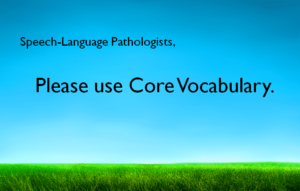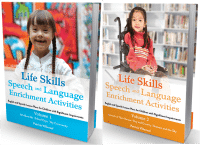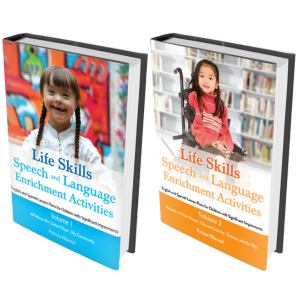Core Vocabulary is the Key
Today I want for all of us to start thinking about our students and clients who are non-verbal. How do we do speech therapy for individuals who are non-verbal? I will be the first to say that the letters AAC (augmentative and alternative communication) overwhelm me. AAC is an umbrella term that includes all of the communication methods used to support or replace speech or writing for those with impairments in the production or comprehension of spoken or written language. Recent years have brought much attention to the use of electronic devices to support the communication needs of our students and clients. This is valuable; however, we need to take the time to understand that an electronic device only serves as medium. At the end of the day, we still need to talk content. What vocabulary do we need to address? I am here to tell you that Core Vocabulary is the only way to go. As a speech-language pathologist for a middle school Life Skills classroom, using Core Vocabulary has yielded so much meaningful communication.
What is Core Vocabulary?

So, what is Core Vocabulary? Core vocabulary words are high frequency, reusable, generic words. They comprise 80-90% of the words we use (e.g., want, more, put, I, mine, go, all done). Core Vocabulary is important because it promotes generative language. In other words, your child is not limited to requesting nouns (e.g., I want cookie). And, by using Core Vocabulary, you are giving your child access to 50-300 high frequency, re-usable words and variations of words. The best part is that he can use these words across a variety of events or activities throughout his entire life.
4 Tips for Using Core Vocabulary
Here are some important pieces of information:
Give Access. Please make sure you provide your child with a communication system. This could be the Core Vocabulary board provided to you. This could also be a communication device you already own. Remember, give your child full access to a consistent communication system. This will give him the opportunity to let us know what he wants and how he feels, and let him give commentary on everyday activities. During the last few weeks, students have used the Core Vocabulary board to tell me they want (a request/want) to talk to a friend, they’re mad (feelings) following a bowling spare and that something was funny (share in humor).
Model, Model, Model. If your student is still learning how to use a communication system, please model the language for him. Remember, we model language for babies for approximately 9-12 months before they utter their first “mama” or “dada.” And, babies have likely heard the same word hundreds to thousands of times before saying it for the first time. So, we are going to model often. For example, you could point to “I,” “want” and “go” every time you go somewhere.
Know Gail Van Tatenhove. Please refer to Gail Van Tatenhove’s work for support in implementing a communication system. Her YouTube channel provides content and visuals for using these important communication systems. And, here is a powerful, one-minute video showing the value of Core Vocabulary:
Have fun. Know that communication, at the end of the day, is best used to create meaningful (and fun) experiences. I am also including the Core Vocabulary board I used for bowling. My students had a great time at bowling this year, and the created opportunities to talk about how they did, feelings following a turn and vocabulary for steps taken when bowling (e.g., putting on shoes, getting ball). So, have fun!
You should also take a moment to review our easy-to-use, functional books created to support those working on their life skills. This tool was created out of necessity as we supported our students, and we are happy to share it with you.
We also have an online course that demonstrates how we use this book effectively with our students in Life Skills programs.





Awesome!
Thanks, Ann! We hope the information is useful for you.
That video touched and moved me in a very profound way. The need is huge and the lack of insight is huge. Thank you for sharing this video.
Marie, thank you so much for your message. And, you’re right. This is a huge, important area of our field that needs greater support. Using Core Vocabulary maximizes our efforts, and our students/clients are then able to do more than just say “I want X”–they can now comment, ask questions, use humor, and make needs/wants known. The work we do is important, and we are lucky to do it.
Really like your bowling fringe vocab on your core board, Phuong. Have you shared a BM version of the board anyplace?
Leslie
Hi Leslie,
At the time, I did not have Boardmaker. So, I made the board using a the “snipping tool” on my computer. Once I have access to the program, I will gladly make and post it. I will say that the use of the Core Board and the associated fringe vocabulary was a great way to promote communication. Leslie, I used this when I was at a middle school in AISD, and we spent our Friday mornings at the bowling ally. Wouldn’t it be great to give this to all the classrooms that attended the weekly bowling activity?!
I’m a big fan of core communication boards – try to always have one in hand on my campuses. I really want to get my FLS teachers and TAs to buy in to their use and thought your bowling vocab might be a good hook. Your board is terrific; I just want to add a toilet symbol and I don’t have your tech savvy!
Leslie,
Your wish is my command, dear. I’m emailing you the updated version with the toilet symbol, and I’ll update the chart in the post. Thanks for your feedback!
Hi, where can I find the Core Vocabulary on your website? Can’t seem to locate it. Thanks in advance.
Nanette,
Currently, we do not have Core Vocabulary boards on our site. This is definitely something we can work on to provide SLPs. I would definitely check out Gail Van Tatenhove’s work on Core Vocabulary. Thank you for your feedback. It makes us be better at supporting SLPs.